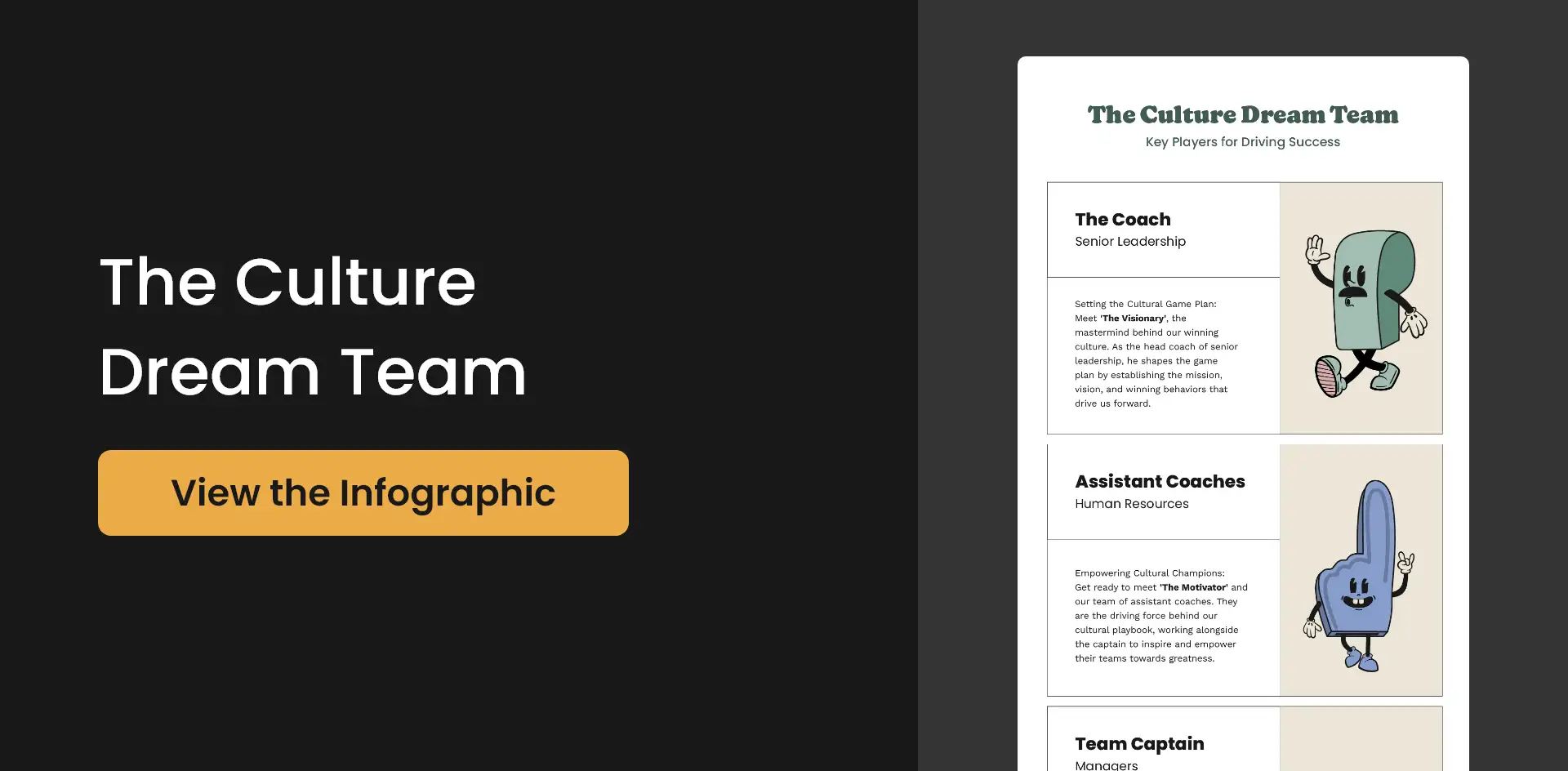What is organizational culture and what contributes to it?
Organizational culture consists of the values, beliefs, attitudes, and behaviors that employees share and use daily in their work.
The organizational culture shapes how employees describe their workplace, understand the business, and see themselves as part of the team. It’s formed by the values, beliefs, attitudes, and behaviors that everyone shares and uses daily. It can even drive decisions, actions, and overall performance.
What Would Your Employees Say?
Imagine your employees describing your company culture in an employee survey. Would you hear these positive responses?
- “This is a fun place to work.”
- “We are focused on results.”
- “Everyone here cares about each other like family.”
- “This is a great place to learn and grow.”
Or would you hear more negative descriptions, like these?
- “You can’t speak up without fear of retribution.”
- “I don’t feel trusted to do my job.”
- “Things have changed. We’re more corporate now. It used to feel like family.”
- “I don’t see how my work contributes to the company’s goals.”
Culture can develop organically or through deliberate planning and action. Either way, it’s a significant part of the employee experience. The best organizations understand their culture and take steps to manage and promote it effectively. They gather feedback from employees to see how aligned they are with the current and desired culture.
Ready to Evaluate Your Culture?
Here are 12 key attributes to consider. We’ll dive into each one in detail.
- Respect/Fairness
- Trust/Integrity
- Change/Adaptability
- Results Orientation
- Teamwork
- Employee Engagement
- Responsibility/Accountability
- Learning Opportunities
- Meaning/Purpose
- Communication
- Decision Making
- Goals/Strategy
12 Ways To Evaluate Your Organization’s Attributes of Culture:
1. Respect/Fairness: Fostering a workplace where every individual feels treated with fairness and respect is foundational. To achieve this, consider the following actions:
- Anonymous Surveys: Regularly gauge employee feelings of fairness and respect through anonymous feedback.
- Bias Awareness Training: Educate managers and employees to recognize and address unconscious biases.
- Equitable Policies: Review and refine policies to ensure clarity, consistency, and fair application.
2. Trust/Integrity: Building trust and upholding integrity are cornerstones of a successful organization. Here are practical steps to foster open communication, empower autonomy, and address ethical concerns promptly:
- Open Communication: Share relevant information transparently, even during challenges.
- Empower Autonomy: Trust employees to make decisions and complete tasks independently.
- Ethical Concerns: Establish clear channels for reporting misconduct and ensure thorough investigations.
3. Change/Adaptability: Embracing change as a competitive advantage requires strategic planning. To promote adaptability and effective change management, consider these actions:
- Change Management Plan: Define clear communication strategies, timelines, and support systems for change.
- Employee Involvement: Seek employee input on proposed changes and address concerns proactively.
- Recognition of Adaptability: Celebrate successes and learnings from change, recognizing those who embrace it.
4. Results Orientation: Driving organizational success requires a results-oriented approach. To ensure accountability, goal attainment, and a culture that fosters the right behaviors, consider the following actions:
- Set Clear Goals: Ensure all employees understand organizational and individual goals and their contributions.
- Track Progress and Feedback: Regularly assess progress and provide constructive feedback to help individuals and teams improve.
- Reward Results: Recognize and reward those who consistently deliver results based on established metrics.
5. Teamwork: Effective collaboration is a hallmark of a strong organizational culture. To enhance teamwork, establish clear expectations, communication channels, and promote shared ownership:
- Cross-Functional Collaboration: Foster projects and initiatives that require teamwork across departments.
- Communication Channels: Ensure teams have access to necessary information and tools for collaboration.
- Shared Ownership: Hold team members accountable for their individual roles and collective success.
6. Employee Engagement: Valuing and engaging employees is key to organizational success. To create a work environment where people can thrive, consider these actions:
- Measure Engagement Regularly: Use pulse surveys to gauge engagement levels and identify areas for improvement.
- Invest in Development: Provide opportunities for professional growth through training, mentoring, and skill-building.
- Recognize Contributions: Acknowledge and celebrate individual and team achievements to boost morale and engagement.
7. Responsibility/Accountability: Promoting responsibility and accountability is crucial for a healthy workplace culture. To achieve this, empower ownership, foster a learning culture, and address performance issues promptly:
- Empower Ownership: Encourage employees to take initiative and hold them accountable for decisions and actions.
- Learning Culture: Create an environment where employees feel safe to take risks and learn from mistakes.
- Performance Issues: Have clear expectations and provide timely feedback and support to address performance concerns.
8. Learning Opportunities: Providing growth opportunities for employees contributes to a vibrant organizational culture. To focus on learning, consider these actions:
- Personalized Learning Plans: Create customized learning plans for each employee based on their career goals.
- On-the-Job Training and Mentorship: Provide opportunities to learn from experienced colleagues and challenging projects.
- Support External Learning: Encourage participation in conferences and workshops relevant to their roles.
9. Meaning/Purpose: Aligning the mission and values with employee perspectives is essential. To connect work to impact and foster a sense of purpose, consider the following actions:
- Articulate a Clear Mission and Values: Ensure your organization’s mission and values are clearly defined and communicated.
- Connect Work to Impact: Help employees understand how their work contributes to the organization’s mission and impact.
- Social Responsibility: Promote volunteer opportunities and charitable activities aligned with your values.
10. Communication: Effective communication is a cornerstone of organizational culture. To enhance communication, establish diverse channels, practice active listening, and respond promptly:
- Diverse Communication Channels: Define channels for different levels and types of information, utilizing various methods.
- Active Listening: Encourage open and honest communication by actively listening to employee concerns.
- Prompt and Transparent Responses: Provide timely and transparent responses to employee questions and inquiries.
11. Decision Making: Empowering employees in decision-making contributes to a dynamic culture. To achieve this, delegate authority, provide clear frameworks, and seek diverse perspectives:
- Empower Decision-Making: Delegate decision-making authority to employees within their areas of expertise.
- Clear Decision-Making Frameworks: Establish clear guidelines and processes for making different types of decisions.
- Seek Diverse Perspectives: Encourage input from diverse stakeholders before making important decisions.
12. Goals/Strategy: Aligning individual and organizational goals is crucial for success. To ensure alignment and progress, consider the following actions:
- Communicate Goals Clearly: Ensure all employees understand the organization’s overall goals and strategy.
- Align Individual Goals: Help employees set individual goals that contribute to organizational objectives.
- Track Progress and Adapt: Regularly monitor progress towards goals and adapt the strategy based on feedback and learnings.
Some of these attributes of company culture might match your organization’s values. Shared values are also important because they describe the way we achieve the overall mission of the organization. Values can be used to describe your culture. For example, “We have a performance-based culture that encourages open and honest discussion and challenges the status quo.”
If new hires don’t feel like their workplace values align with their own, it might be time to re-evaluate your organizational culture. Conduct a thorough assessment to identify the ideal culture for your organization.
Analyze employee survey results to understand your current work environment. Identify desirable cultural attributes to preserve and develop a plan to eliminate negative aspects. Communicate the desired culture to both employees and leaders. Regularly track progress and employee feedback to assess the impact of changes. Remember, building a strong culture takes time and consistent effort. Align your daily practices and stories with the desired cultural attributes.




